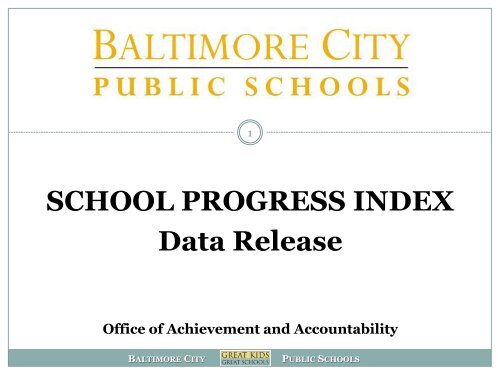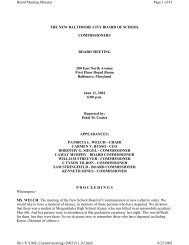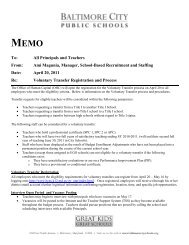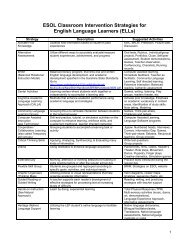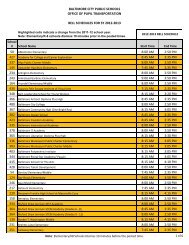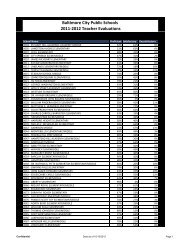What is the School Progress Index? - Baltimore City Public Schools
What is the School Progress Index? - Baltimore City Public Schools
What is the School Progress Index? - Baltimore City Public Schools
You also want an ePaper? Increase the reach of your titles
YUMPU automatically turns print PDFs into web optimized ePapers that Google loves.
1<br />
SCHOOL PROGRESS INDEX<br />
Data Release<br />
Office of Achievement and Accountability<br />
BALTIMORE CITY<br />
PUBLIC SCHOOLS
<strong>What</strong> <strong>is</strong> <strong>the</strong> <strong>School</strong> <strong>Progress</strong> <strong>Index</strong>?<br />
2<br />
• The <strong>School</strong> <strong>Progress</strong> <strong>Index</strong> (SPI) <strong>is</strong> <strong>the</strong> measure Maryland has<br />
developed to replace Adequate Yearly <strong>Progress</strong> (AYP), <strong>the</strong><br />
federal accountability measure used for schools under No<br />
Child Left Behind.<br />
• On December 17, MSDE will release an SPI for all schools<br />
statewide based on 2011-12 data.<br />
◦ The SPI for 2011-12 has zero stakes<br />
◦ Next fall schools will receive a score for <strong>the</strong> SPI for <strong>the</strong> 2012-13 year—with<br />
stakes
How <strong>is</strong> <strong>the</strong> SPI different from AYP?<br />
• AYP measured student proficiency for schools and required all<br />
schools to achieve a universal level of proficiency for all<br />
students over 12 years.<br />
◦ Goal: all students at all schools are proficient by 2014<br />
• The SPI measures student progress for schools and requires<br />
schools to meet a yearly progress standard based on <strong>the</strong>ir level<br />
or proficiency <strong>the</strong> prior year.<br />
◦ Goal: Cut <strong>the</strong> number of non-proficient students in half by 2017<br />
• Also:<br />
◦ The SPI has more real<strong>is</strong>tic and comprehensive indicators<br />
◦ With <strong>the</strong> SPI, schools are measured against <strong>the</strong>ir own progress, not<br />
compared to o<strong>the</strong>r schools<br />
3
<strong>What</strong> does <strong>the</strong> SPI measure?<br />
• For all grades, <strong>the</strong> SPI looks at three key indicators<br />
◦ For elementary and middle schools <strong>the</strong>se are achievement, gap<br />
reduction and growth<br />
◦ For high schools <strong>the</strong>se are achievement, gap reduction and<br />
college and career readiness<br />
• Each of <strong>the</strong>se indicators <strong>is</strong> weighted based on its<br />
importance in assessing overall school progress<br />
◦ For elementary and middle school SPIs: Achievement = 30%;<br />
Gap Reduction = 40%; Growth = 30%<br />
◦ For high school SPIs: Achievement = 40%;<br />
Gap Reduction = 40%; College/Career Readiness = 20%<br />
4
Maryland’s <strong>School</strong> <strong>Progress</strong> <strong>Index</strong><br />
Meeting<br />
Performance<br />
Targets<br />
(AMO)<br />
Grades PreK-8<br />
Achievement* 30%<br />
• 33.3%- Ma<strong>the</strong>matics Proficiency (MSA)<br />
• 33.3%- Reading Proficiency (MSA)<br />
• 33.3%- Science Proficiency (MSA)<br />
Meeting<br />
Performance<br />
Targets<br />
(AMO)<br />
Grades 9-12<br />
Achievement* 40%<br />
• 33.3%- Ma<strong>the</strong>matics Proficiency (Algebra/<br />
Data Analys<strong>is</strong> HSA)<br />
• 33.3%- Engl<strong>is</strong>h Proficiency (Engl<strong>is</strong>h HSA)<br />
• 33.3%- Science Proficiency (Biology HSA)<br />
Gap* 40%<br />
Gap between lowest subgroup and highest<br />
subgroup within a school:<br />
• 33.3%- Ma<strong>the</strong>matics Proficiency (MSA)<br />
• 33.3%- Reading Proficiency (MSA)<br />
• 33.3%- Science Proficiency (MSA)<br />
Growth* 30%<br />
Percent of students making one year’s growth:<br />
• 50%- Ma<strong>the</strong>matics Proficiency (MSA)<br />
• 50%- Reading Proficiency (MSA)<br />
*ALT-MSA <strong>is</strong> included in <strong>the</strong> index component<br />
Source: Maryland State Department<br />
of Education<br />
Gap*<br />
Gap between lowest subgroup and highest<br />
subgroup within a school:<br />
• 20%- Ma<strong>the</strong>matics Proficiency (Algebra/<br />
Data Analys<strong>is</strong> HSA)<br />
• 20%- Engl<strong>is</strong>h Proficiency (Engl<strong>is</strong>h HSA)<br />
• 20%- Science Proficiency (Biology HSA)<br />
• 20%- Cohort Graduation Rate<br />
• 20%- Cohort Dropout Rate<br />
College-and Career-Readiness*<br />
20%<br />
40%<br />
• 60%- Cohort Graduation rate<br />
• 40%- College and Career Preparation (CCP)<br />
• Advanced Placement or International Baccalaureate<br />
• Career and Technology Education (CTE)<br />
Concentrators<br />
• College Enrollment<br />
Rev<strong>is</strong>ed<br />
11/26/12
Annual Measureable Objectives (AMO)<br />
6<br />
• For each indicator <strong>the</strong>re are Annual Measureable<br />
Objectives, or AMOs<br />
◦ AMOs are performance targets that assess <strong>the</strong> progress of<br />
schools and subgroups<br />
◦ AMOs are based on schools’ performance in prior years<br />
• AMOs reflect <strong>the</strong> goal to reduce <strong>the</strong> number of<br />
“non-adequate” students between a baseline year 1<br />
and target year 2<br />
1<br />
For most metrics, <strong>the</strong> baseline year was 2011; exceptions are for metrics that are lagged by one or two years.<br />
2<br />
The target year <strong>is</strong> 2017 for all metrics except graduation and dropout rates. For <strong>the</strong>se, <strong>the</strong> target year <strong>is</strong> 2020.<br />
Source: Maryland State Department<br />
of Education
ELEMENTARY/MIDDLE/HIGH SCHOOL<br />
Indicator: Achievement<br />
• Percentage of “all students” group scoring proficient<br />
or advanced on Maryland standardized assessments<br />
progressing toward targets<br />
• Th<strong>is</strong> <strong>is</strong> about progress, not performance<br />
• PreK-8<br />
◦ MSA Math Proficiency<br />
◦ MSA Reading Proficiency<br />
◦ MSA Science Proficiency<br />
• Grades 9-12<br />
◦ HSA Algebra/Data Analys<strong>is</strong> Proficiency<br />
◦ HSA Engl<strong>is</strong>h Proficiency<br />
◦ HSA Biology Proficiency<br />
7<br />
Source: Maryland State Department<br />
of Education
ELEMENTARY/MIDDLE/HIGH SCHOOL<br />
Indicator: Gap Reduction<br />
8<br />
• Decrease in performance gap between <strong>the</strong> highest and lowest<br />
performing subgroups<br />
• Gap score calculated for each subgroup category in each<br />
measured area<br />
• Pre-K-8<br />
◦ MSA Math Proficiency<br />
◦ MSA Reading Proficiency<br />
◦ MSA Science Proficiency<br />
• Grades 9-12<br />
◦ HSA Algebra/Data Analys<strong>is</strong> Proficiency<br />
◦ HSA Engl<strong>is</strong>h Proficiency<br />
◦ HSA Biology Proficiency<br />
◦ 5-Year Adjusted Cohort Graduation Rate<br />
◦ 4-Year Adjusted Cohort Dropout Rate<br />
Source: Maryland State Department<br />
of Education
ELEMENTARY/MIDDLE<br />
Indicator: Growth<br />
9<br />
• The change in student performance for <strong>the</strong> “all<br />
students” group between <strong>the</strong> current year and prior<br />
year<br />
• PreK-8<br />
◦ MSA Math Proficiency<br />
◦ MSA Reading Proficiency<br />
Source: Maryland State Department<br />
of Education
HIGH SCHOOL<br />
Indicator: College & Career Readiness (CCR)<br />
• Met annual targets on measures that assure students are<br />
ready for college or career upon graduation<br />
10<br />
◦ 5-year cohort adjusted graduation rate<br />
◦ College and Career Preparation—students who have exited high school with a<br />
Maryland high school diploma and meet any one of <strong>the</strong> following:<br />
Advanced Placement (AP) or International Baccalaureate (IB)<br />
Earned a score of 3 or greater on an AP exam<br />
Earned a score of 4 or greater on an IB exam<br />
Career and Technology Education (CTE) Concentrators<br />
Attained advance standing in a state-approved CTE program of study<br />
College Enrollment<br />
Entered a post-secondary institution within 16 months of graduation<br />
Source: Maryland State Department<br />
of Education
SPI Strands<br />
•The SPI score <strong>is</strong> used to place each school into 1 of 5 strands, 1 being <strong>the</strong> highest and 5 being<br />
<strong>the</strong> lowest.<br />
•Strands are designed to categorize schools to provide support, intervention and<br />
recognition.<br />
Strand<br />
SEA/LEA<br />
11<br />
1 The school should be able to identify <strong>the</strong> professional development and training that can lead<br />
to additional improvement in achievement. The LEA may provide th<strong>is</strong> resource or schools can<br />
seek training beyond <strong>the</strong>ir own LEAs.<br />
2 MSDE will dictate no specific support for schools in strand 2. It <strong>is</strong> expected that LEAs will take<br />
particular interest in <strong>the</strong> specific needs in <strong>the</strong>se schools.<br />
3 All schools in strand 3 will develop <strong>School</strong> Improvement Plans to be monitored by <strong>the</strong> LEA.<br />
Title I schools that fall into th<strong>is</strong> Strand will be eligible to apply for 1003(a) <strong>School</strong><br />
Improvement Grant funds.<br />
4 Improvement of instruction, <strong>the</strong> replacement or <strong>the</strong> retraining of <strong>the</strong> leadership staff, and<br />
intensified outreach to families to become involved with <strong>the</strong>ir child’s school should be<br />
addressed by <strong>the</strong> schools with LEA oversight.<br />
5 Those Title I schools in th<strong>is</strong> strand will have access to additional school improvement dollars.<br />
For non- Title I schools, <strong>the</strong> SIG process which provides clear needs assessments and support<br />
through <strong>the</strong> LEA Turnaround offices will continue to be employed.<br />
BALTIMORE CITY<br />
PUBLIC SCHOOLS
Strand Categorization<br />
12<br />
Strand<br />
Overall Score<br />
Number of Indicators Met<br />
E, M, H EM, MH, EH EMH<br />
1 1.0 or greater All 3 All 6 All 9<br />
2<br />
2 of 3 4-5 of 6 6-8 of 9<br />
Greater than or<br />
3 1 of 3 2-3 of 6 3-5 of 9<br />
equal to 0.9<br />
4 0 of 3 0-1 of 6 0-2 of 9<br />
5 Less than 0.9 0-2 of 3 0-4 of 6 0-6 of 9<br />
• Number of indicators met includes:<br />
◦ indicators where <strong>the</strong> percent proficient of target for <strong>the</strong> overall indicator <strong>is</strong> greater than or equal to 1<br />
◦ indicators that were not evaluated due to small population<br />
• E, M, H defines a particular grade span for a school.<br />
◦ E – Elementary<br />
◦ M – Middle<br />
◦ H – High<br />
*Some schools may have multiple grade spans (i.e. a school with grades 6-12 <strong>is</strong> e a MH school).<br />
Source: Maryland State Department<br />
of Education
Number of <strong>School</strong>s in Each SPI Strand<br />
in 2012<br />
13<br />
Based on 2012 data, nearly all schools fell into <strong>the</strong> top 3 strands<br />
78<br />
53<br />
49<br />
6 4<br />
Strand 1 Strand 2 Strand 3 Strand 4 Strand 5<br />
Note: 2012 SPI Results are not for stakes.<br />
BALTIMORE CITY<br />
PUBLIC SCHOOLS
2012 SPI Results for Maryland and <strong>Baltimore</strong> <strong>City</strong><br />
14<br />
<strong>City</strong> <strong>School</strong>s had a higher proportion of schools in <strong>the</strong> top 3 strands and a<br />
lower proportion of schools in <strong>the</strong> bottom 2 strands than Maryland overall<br />
37.3<br />
41.1<br />
26.3<br />
27.9<br />
24.1<br />
25.8<br />
8<br />
3.2 4.3<br />
2.1<br />
Strand 1 Strand 2 Strand 3 Strand 4 Strand 5<br />
Maryland<br />
<strong>Baltimore</strong> <strong>City</strong><br />
Note: 2012 SPI Results are not for stakes. Results for Maryland are taken from mdreportcard.org<br />
BALTIMORE CITY<br />
PUBLIC SCHOOLS
ELEMENTARY/MIDDLE<br />
SPI Example Calculation<br />
15<br />
Calculations Achievement Gap Growth<br />
% of Students who<br />
Scored Advanced or<br />
Proficient<br />
Math Read Sci Math Read Sci Math Read<br />
89.24% 93.72% 65.82% 74.55% 86.24% 66.00% 57.04% 89.63%<br />
AMO 87.57% 87.94% 75.48% 74.92% 78.20% 59.20% 74.06% 84.82%<br />
= Measure PSV 1.0191 1.0657 0.8720 0.9951 1.1028 1.1150 0.7702 1.0567<br />
Proportional<br />
Significance<br />
= Measure<br />
Contribution<br />
33.33% 33.33% 33.33% 33.33% 33.33% 33.33% 50% 50%<br />
0.3397 + 0.3552 + 0.2906 0.3317 + 0.3676 + 0.3717 0.3851 + 0.5284<br />
= Indicator PSV 0.9855 1.0709 0.9134<br />
Proportional<br />
Significance<br />
= Indicator<br />
Contribution<br />
30% 40% 30%<br />
0.2957 + 0.4284 + 0.2740<br />
= <strong>School</strong> <strong>Index</strong> <strong>Progress</strong> Scale Value 0.9981<br />
Source: Maryland State Department<br />
of Education
Percent of <strong>City</strong> <strong>School</strong>s’ Elementary <strong>School</strong>s<br />
Meeting 2012 AMO’s by Subject<br />
16<br />
Achievement Gap Reduction Growth<br />
92.1<br />
57.8 57.1<br />
47.2<br />
73.2<br />
67.5 66.9<br />
34.4<br />
N= 128 128 125 126 126 90 127 127<br />
NA<br />
Math Reading Science<br />
*The Growth Indicator does not include Science as a measure because students are not assessed in consecutive years.<br />
BALTIMORE CITY<br />
PUBLIC SCHOOLS
Percent of <strong>City</strong> <strong>School</strong>s’ Middle <strong>School</strong>s<br />
Meeting 2012 AMO’s by Subject<br />
17<br />
Achievement Gap Reduction Growth<br />
67.7<br />
85.9<br />
77.4<br />
54.7<br />
54.4 55.7<br />
30.2<br />
37.4<br />
N= 106 106 99 102 103 71 106 106<br />
NA*<br />
Math Reading Science<br />
*The Growth Indicator does not include Science as a measure because students are not assessed in consecutive years.<br />
BALTIMORE CITY<br />
PUBLIC SCHOOLS
HIGH SCHOOL<br />
SPI Calculation Example<br />
18<br />
Variable Achievement Gap CCR<br />
Assessment Alg Eng Bio Alg Eng Bio Grad Drop Grad CCP<br />
% Proficient CY 0.9608 0.9083 0.9233 0.6816 0.6100 0.8224 0.6248 0.7590 0.9265 0.8880<br />
Target 0.8591 0.8662 0.8981 0.7240 0.7407 0.8577 0.8852 0.9489 0.8113 0.8794<br />
% Prof of Target 1.1184 1.0486 1.0281 0.9414 0.8236 0.9589 0.7058 0.7998 1.1420 1.0098<br />
Content Weight 0.3333 0.3333 0.3333 0.2000 0.2000 0.2000 0.2000 0.2000 0.6000 0.4000<br />
Weighted<br />
% Prof of Target 0.3728 0.3495 0.3427 0.1883 0.1647 0.1918 0.1412 0.1600 0.6852 0.4039<br />
Sum Weighted %<br />
Prof of Target 1.0649 0.8459 1.0891<br />
Indicator Weight 0.40 0.40 0.20<br />
Indicator<br />
Contribution 0.4260 0.3384 0.2178<br />
<strong>School</strong> <strong>Index</strong> 0.9822<br />
% Prof of Target = % Proficient CY ÷ Target<br />
Weighted % Prof of Target = % Prof of Target x Content Weight<br />
Indicator Contribution<br />
= (Math + Read + Sci) x Indicator Weight<br />
<strong>School</strong> <strong>Index</strong><br />
= (Achievement + Growth + Gap)<br />
* Source: Maryland State<br />
Department of Education
Percent of <strong>City</strong> <strong>School</strong>s’ High <strong>School</strong>s<br />
Meeting 2012 AMO’s by Subject<br />
19<br />
Achievement Gap Reduction College/Career<br />
Readiness<br />
86.1<br />
78.6<br />
72.1<br />
61.1<br />
66.7 68.4<br />
38.3<br />
46.8<br />
42.6<br />
32.4<br />
N= 47 47 47 42 43 43 36 33 38 34<br />
Math Reading Science Graduation Rate Dropout Rate College/Career Prep<br />
BALTIMORE CITY<br />
PUBLIC SCHOOLS


